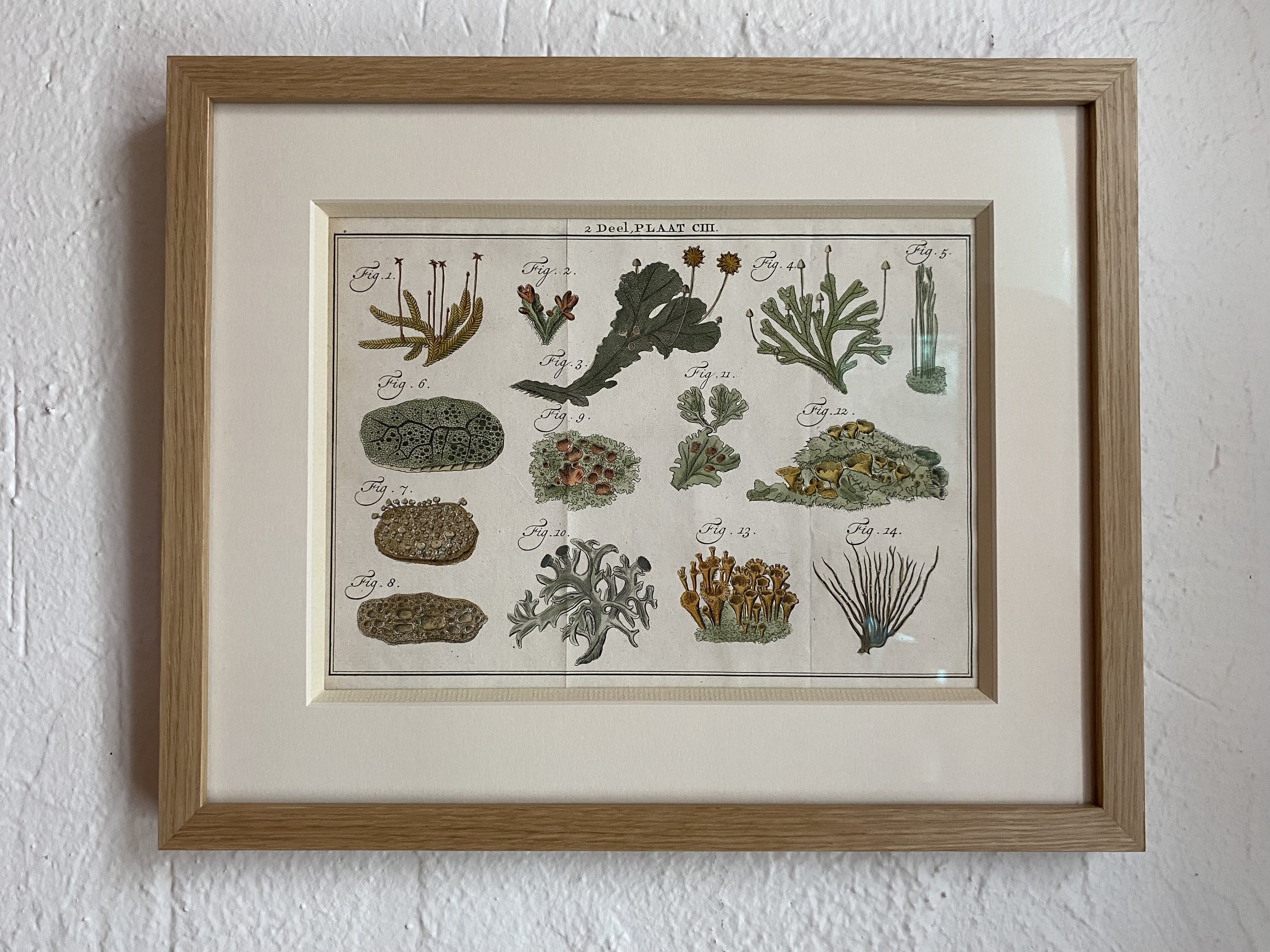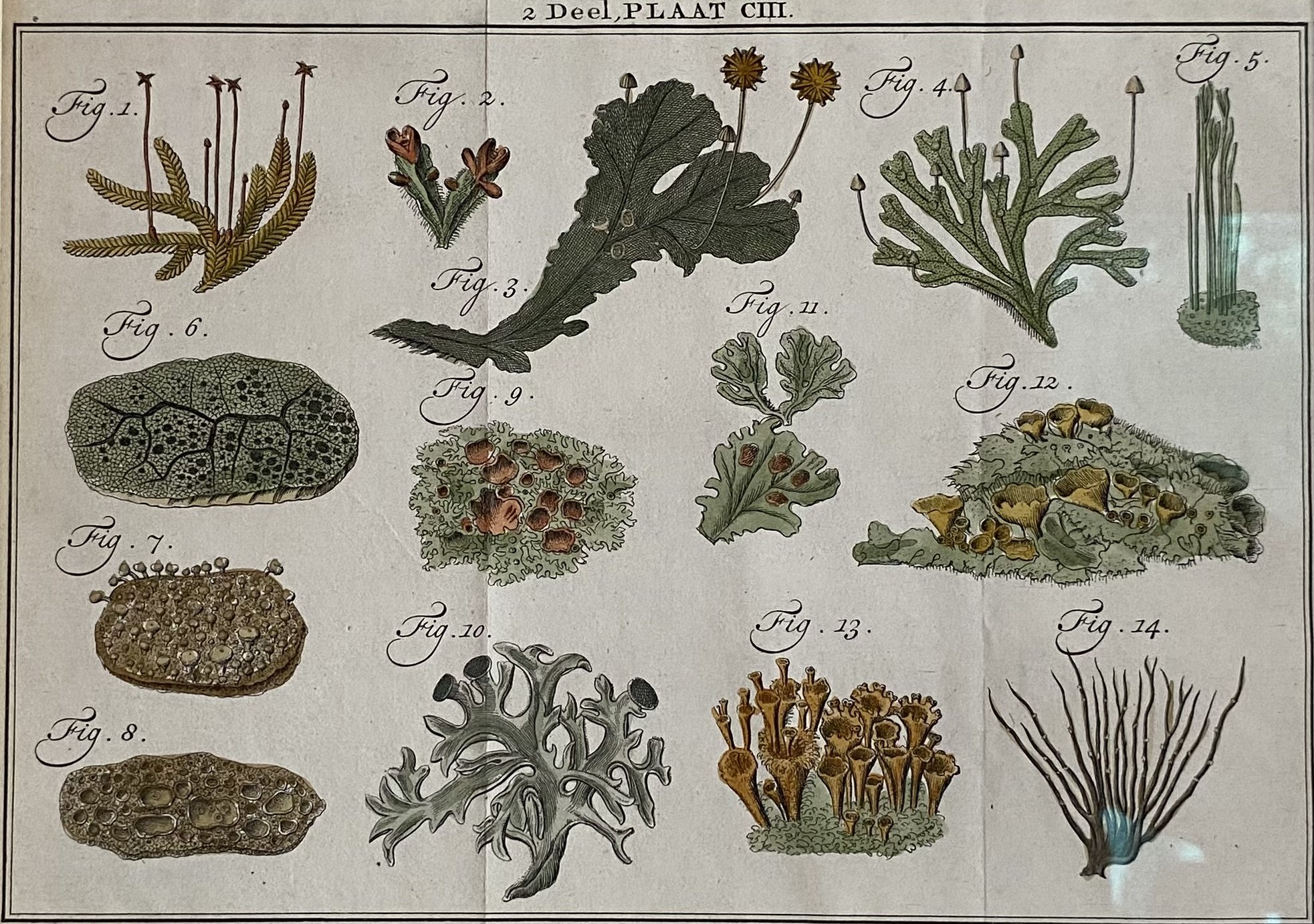 Image 1 of 3
Image 1 of 3

 Image 2 of 3
Image 2 of 3

 Image 3 of 3
Image 3 of 3




Birch-Framed, Original, 18th-Century, Dutch Botanical Print
This print featuring fourteen varieties of lichen, was produced as an original copperplate engraving on verge type, handmade paper, with hand coloring. It comes from the 37-volume Dutch botany guide, Natuurlyke Historie of Uitvoerige Beschryving der Dieren, Planten en Mineraalen (Natural History or Extensive Description of Animals, Plants and Minerals) published in Amsterdam between 1761 and 1785. The work is a Dutch translation by Martinus Houttuyn of the Linnaeus Systema Naturae by the founder of modern taxonomy, the Swedish botanist, Carl Linnaeus (1707-1798).
Botanical prints are synonymous with the Victorian era, when they reached their height of popularity. But the history of these prints stretches back to the mid-18th century when European naturalists, amateur and trained, became obsessed with observing and cataloguing the world systemically and often in beautifully detailed drawings and paintings. The first botanical prints were, like this one, engravings, usually on metal plates.
I tracked down this lichen print from Pictura Antique Prints in Overasselt, a picturesque village in The Netherlands. Run by a former landscape architect, Peter Cornelissen, Pictura counts the Metropolitan Museum of Art and the Rijksmuseum among its clients.
The museum quality birch frame and mounting has its own story. I spotted this beautiful type of window mat in a small picture hanging in the window at a Japanese antique dealer on a side street in the 6th Arrondissement in Paris. Days later I couldn’t stop thinking about the way the subtle, beveled edge of the inside window mat set off the picture so beautifully. Obsessed, I returned to photograph it. A few years later, I brought my photo to an art framing store in the Berkshires, where they helped me figure out how to replicate the look.
The size of the print is ca. 10.6 x 8.3 inch. The frame is x by y.
This print featuring fourteen varieties of lichen, was produced as an original copperplate engraving on verge type, handmade paper, with hand coloring. It comes from the 37-volume Dutch botany guide, Natuurlyke Historie of Uitvoerige Beschryving der Dieren, Planten en Mineraalen (Natural History or Extensive Description of Animals, Plants and Minerals) published in Amsterdam between 1761 and 1785. The work is a Dutch translation by Martinus Houttuyn of the Linnaeus Systema Naturae by the founder of modern taxonomy, the Swedish botanist, Carl Linnaeus (1707-1798).
Botanical prints are synonymous with the Victorian era, when they reached their height of popularity. But the history of these prints stretches back to the mid-18th century when European naturalists, amateur and trained, became obsessed with observing and cataloguing the world systemically and often in beautifully detailed drawings and paintings. The first botanical prints were, like this one, engravings, usually on metal plates.
I tracked down this lichen print from Pictura Antique Prints in Overasselt, a picturesque village in The Netherlands. Run by a former landscape architect, Peter Cornelissen, Pictura counts the Metropolitan Museum of Art and the Rijksmuseum among its clients.
The museum quality birch frame and mounting has its own story. I spotted this beautiful type of window mat in a small picture hanging in the window at a Japanese antique dealer on a side street in the 6th Arrondissement in Paris. Days later I couldn’t stop thinking about the way the subtle, beveled edge of the inside window mat set off the picture so beautifully. Obsessed, I returned to photograph it. A few years later, I brought my photo to an art framing store in the Berkshires, where they helped me figure out how to replicate the look.
The size of the print is ca. 10.6 x 8.3 inch. The frame is x by y.
This print featuring fourteen varieties of lichen, was produced as an original copperplate engraving on verge type, handmade paper, with hand coloring. It comes from the 37-volume Dutch botany guide, Natuurlyke Historie of Uitvoerige Beschryving der Dieren, Planten en Mineraalen (Natural History or Extensive Description of Animals, Plants and Minerals) published in Amsterdam between 1761 and 1785. The work is a Dutch translation by Martinus Houttuyn of the Linnaeus Systema Naturae by the founder of modern taxonomy, the Swedish botanist, Carl Linnaeus (1707-1798).
Botanical prints are synonymous with the Victorian era, when they reached their height of popularity. But the history of these prints stretches back to the mid-18th century when European naturalists, amateur and trained, became obsessed with observing and cataloguing the world systemically and often in beautifully detailed drawings and paintings. The first botanical prints were, like this one, engravings, usually on metal plates.
I tracked down this lichen print from Pictura Antique Prints in Overasselt, a picturesque village in The Netherlands. Run by a former landscape architect, Peter Cornelissen, Pictura counts the Metropolitan Museum of Art and the Rijksmuseum among its clients.
The museum quality birch frame and mounting has its own story. I spotted this beautiful type of window mat in a small picture hanging in the window at a Japanese antique dealer on a side street in the 6th Arrondissement in Paris. Days later I couldn’t stop thinking about the way the subtle, beveled edge of the inside window mat set off the picture so beautifully. Obsessed, I returned to photograph it. A few years later, I brought my photo to an art framing store in the Berkshires, where they helped me figure out how to replicate the look.
The size of the print is ca. 10.6 x 8.3 inch. The frame is x by y.
